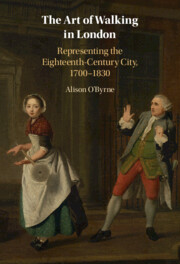Book contents
- The Art of Walking in London
- The Art of Walking in London
- Copyright page
- Dedication
- Contents
- Figures
- Acknowledgements
- Introduction
- Chapter 1 Mobility and Spectatorship in the Early Eighteenth-Century City
- Chapter 2 Promenading the Mall in St James’s Park
- Chapter 3 Imagining the Stranger
- Chapter 4 London Spied
- Chapter 5 Metropolitan Pleasures and Grievances
- Conclusion
- Bibliography
- Index
Conclusion
“Much has chang’d since Trivia trod with Gay”
Published online by Cambridge University Press: 19 December 2024
- The Art of Walking in London
- The Art of Walking in London
- Copyright page
- Dedication
- Contents
- Figures
- Acknowledgements
- Introduction
- Chapter 1 Mobility and Spectatorship in the Early Eighteenth-Century City
- Chapter 2 Promenading the Mall in St James’s Park
- Chapter 3 Imagining the Stranger
- Chapter 4 London Spied
- Chapter 5 Metropolitan Pleasures and Grievances
- Conclusion
- Bibliography
- Index
Summary
The conclusion looks at early nineteenth-century invocations of John Gay’s Trivia as a way of marking the past from the present, before looking in more detail at one work that draws on Gay’s poem in this way. Metropolitan Improvements; or London in the Nineteenth Century celebrates the development and improvements that were reshaping the West End, drawing a distinction between the London described by Gay and Hogarth and the city of “our improved days”. As it surveys the new buildings, streets, canals, and parks that were transforming the cityscape, James Elmes confidently asserts that London in the nineteenth century will be the admiration of foreigners and the text seemingly resolves many of the tensions highlighted in previous chapters between an ideal of the city and its commercial character.
- Type
- Chapter
- Information
- The Art of Walking in LondonRepresenting the Eighteenth-Century City, 1700–1830, pp. 235 - 242Publisher: Cambridge University PressPrint publication year: 2025

